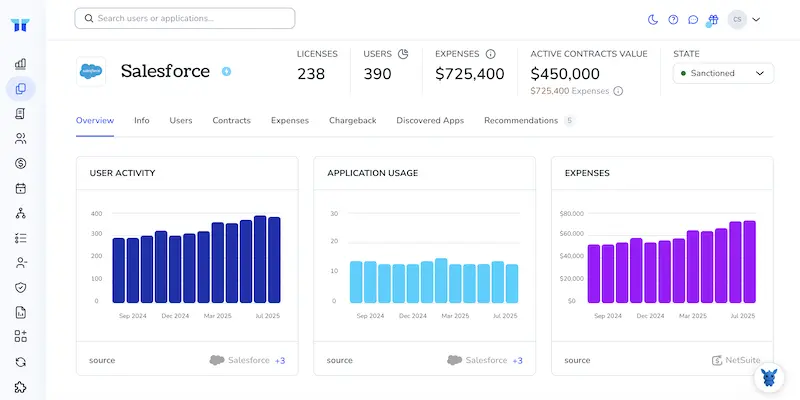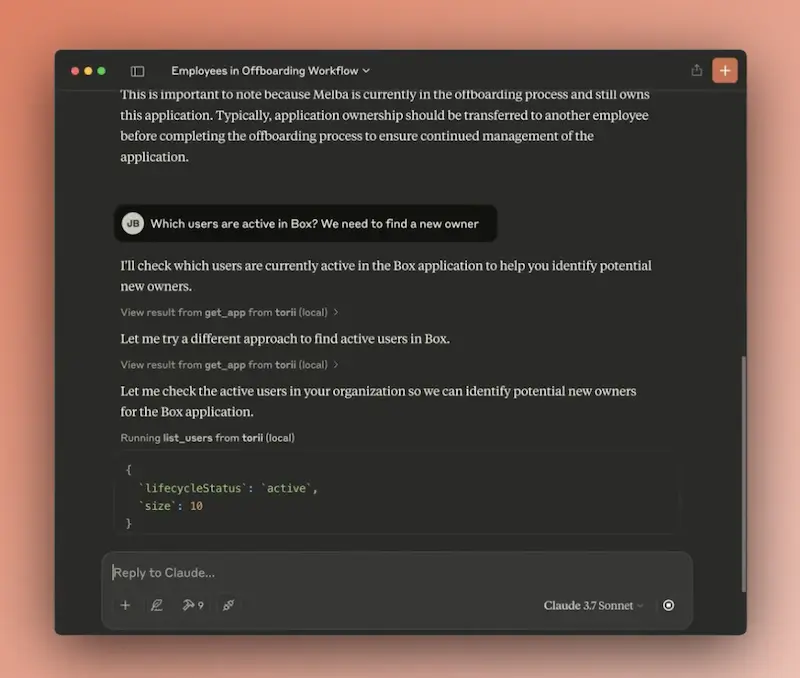4 Ways to Calculate Your Annual Cost for Salesforce

Figuring out what Salesforce really costs each year can feel like trying to hit a moving target. Licenses stack up, add-ons creep in, usage spikes, and suddenly the renewal quote looks nothing like last year.
This guide breaks the puzzle into four clear methods so you can tally every seat, feature, and hidden fee before finance asks. Use whichever approach matches your data, compare the totals, and head into budgeting talks with real numbers.
Table of Contents
Use Salesforce’s UI
These steps show how to check your annual Salesforce subscription costs in the UI.
1. Open the Your Account app
- In Lightning Experience, open the App Launcher (the nine-dot waffle).
- Type “Your Account” in the search field.
- Choose the Your Account app from the list.
Salesforce’s help page, “View and Manage Your Salesforce Subscriptions with the Your Account App,” confirms this is where billing details live.
2. Go to the Subscriptions tab
- The Subscriptions tab sits on the left rail.
- Select it to list every active and past subscription tied to your org.
3. Read the Annual Cost column
- Scan the grid for the “Annual Value” (sometimes labeled “Annual Cost”) column.
- Each row shows the amount billed every contract year for that product bundle.
4. Drill into a subscription for more detail
- Click the subscription name to open its record.
- Look for the Cost Summary section.
- “Annual Value” shows the yearly charge.
- “Total Contract Value” lists the full multi-year total.
- “Term” gives the contract length in months, handy for spotting proration.
5. Export or print the numbers (optional)
- In the upper-right corner of the subscription record, click the down arrow.
- Choose “Download PDF” or “Export CSV.”
A file downloads with the same annual amounts you just viewed, ready for finance or procurement.
6. Repeat for any other active subscriptions
- Return to the Subscriptions tab.
- Open the next record until you have all yearly costs noted or exported.
Use Torii
Instead of pulling cost reports straight from Salesforce, try Torii, a SaaS management platform, to see your annual Salesforce spend. An SMP collects every subscription you run and shows a single reliable snapshot of your entire SaaS stack.
To view your yearly Salesforce costs inside Torii, follow these steps:
1. Sign up for Torii
Contact Torii and request the complimentary two-week proof-of-concept.
2. Connect your Salesforce account to Torii
Once your Torii environment is active, link your existing Salesforce org. The process is quick; simply follow the Salesforce integration guide.
3. Search for Salesforce within Torii
From the Torii dashboard, use the top search bar to look up “Salesforce.” This opens the Salesforce page, where you can review license counts, total spend, renewal dates, and other vital details.

Or, chat with Eko
Torii’s AI assistant, Eko, also pulls Salesforce data directly into the platform. Click the Eko icon at the lower-right corner of the dashboard, enter your Salesforce query, and the results appear immediately in the chat window.

Use Salesforce’s API
Call the Salesforce REST API, run an aggregate SOQL query, then read the response. No clicks involved.
1. Grab an access token
- Send a POST to
https://login.salesforce.com/services/oauth2/token - Include these form parameters:
grant_type=passwordclient_idandclient_secretfrom your connected appusernameandpassword(append the security token to the password if your org still uses one)- The JSON response contains
access_tokenandinstance_url. Save both for upcoming calls.
2. Build an aggregate SOQL query
Pick the object that tracks recurring cost. Common picks:
Opportunitywith a custom checkbox ClosedWon and a custom number fieldAnnual_Cost__cContractwithAnnualValue
(Adjust names to match your org.)
Example query for closed-won opportunities in the current fiscal year:
SELECT SUM(Annual_Cost__c) annualCost
FROM Opportunity
WHERE IsClosed = true
AND IsWon = true
AND CALENDAR_YEAR(CloseDate) = THIS_FISCAL_YEAR
The SUM() function has Salesforce do the math, so you skip post-processing. Details sit in the SOQL Developer Guide under “Aggregate Functions.”
3. Call the Query endpoint
- Method: GET
-
URL:
{instance_url}/services/data/v59.0/query?q={urlEncodedSOQL} - Headers:
Authorization: Bearer {access_token}Content-Type: application/json
Sample curl:
curl \
-H "Authorization: Bearer 00Dxx0000000000.AR8AQH." \
-H "Content-Type: application/json" \
https://mydomain.my.salesforce.com/services/data/v59.0/query?q=SELECT%20SUM(Annual_Cost__c)%20annualCost%20FROM%20Opportunity%20WHERE%20IsClosed%20%3D%20true%20AND%20IsWon%20%3D%20true%20AND%20CALENDAR_YEAR(CloseDate)%20%3D%20THIS_FISCAL_YEAR
4. Read the response
Salesforce replies with JSON like:
{
"totalSize": 1,
"done": true,
"records": [
{
"attributes": { "type": "AggregateResult" },
"annualCost": 247500.0
}
]
}
annualCost holds the summed value for your filter.
5. Tweak filters as needed
- Different fiscal year? Swap
THIS_FISCAL_YEARfor a literal year:CALENDAR_YEAR(CloseDate) = 2024. - Rolling 12 months? Use
CloseDate = LAST_N_MONTHS:12. - Per account? Add
AND AccountId = '001xx000004Txyz'.
6. Automate the pull
- Run the same query on a schedule with your preferred scheduler or integration tool.
- Cache, display, or push the number to another system as needed.
You now have a repeatable, code-only process for surfacing annual cost straight from Salesforce.
Use Claude (via MCP)
Pull this data straight into Claude with the Model Context Protocol (MCP). Claude, Anthropic’s conversational AI, can stand in for ChatGPT.
Follow these steps to show your Salesforce annual spend inside Claude:
1. Connect Torii
Use the earlier Torii connection steps to link your Salesforce workspace to Torii.
2. Enable MCP inside Claude
Start by reviewing the Torii MCP guide and its related article for setup details before you continue.
After installing the Claude Desktop application, insert the following snippet into your claude_desktop_config.json file to point Claude at Torii:
{
"mcpServers": {
"Torii MCP": {
"command": "env",
"args": [
"TORII_API_KEY=YOUR_API_KEY",
"npx",
"@toriihq/torii-mcp"
]
}
}
}
Generate an API key from the Settings page of your Torii console. The key carries the same level of access as your user account, so keep it stored in a safe place.
3. Start the conversation
Open a chat with Claude and start querying your Torii data. Ask for a breakdown of Salesforce licenses, current spend, renewal dates, and any other details you need.

Torii for SaaS Management
Let us know if you’d like a closer, more practical look at modern SaaS management. Torii’s SaaS Management Platform enables you to:
- Uncover shadow apps: AI keeps watch in the background and flags unapproved software the moment it appears.
- Reduce spending: Drop unused licenses and overlapping subscriptions to stop the bleed.
- Automate onboarding and offboarding: Let workflows handle repetitive IT tasks so people can focus on tougher problems.
- Receive proactive renewal reminders: Contracts never sneak up because the platform nudges you well before every renewal date.
Torii brings Finance, IT, and Security teams a shared, reliable picture of every app in use.
For details, real-world case studies, and a quick product tour, head over to Torii to explore.
Frequently Asked Questions
Use four methods: open the Your Account app in Salesforce and read the Annual Value column, check the same data in Torii, send an aggregate SOQL query via the API, or query Torii from Claude. Compare results for one final number.
Inside Lightning, launch the Your Account app, click the Subscriptions tab, and read the Annual Cost column. Open each subscription record for details or choose Download PDF\/Export CSV to hand the figures straight to finance.
Yes. After connecting Salesforce to Torii, search for \"Salesforce\" in the dashboard or ask Eko. Torii instantly shows license counts, renewal dates, and total annual spend, giving finance and IT a single, trusted snapshot.
Authenticate with OAuth, then call \"\/services\/data\/v59.0\/query\" and pass an aggregate SOQL statement like \"SELECT SUM(Annual_Cost__c)…\". Salesforce returns JSON with the annualCost field, which you can schedule and pipe into reports automatically.
Swap date filters such as THIS_FISCAL_YEAR, a literal year, or LAST_N_MONTHS:12, add AccountId for account-level totals, or include custom fields like Annual_Cost__c on Opportunities or Contracts to match your organization’s tracking.
Enable Torii’s MCP server in Claude Desktop, insert your Torii API key in the config, then ask Claude about Salesforce spend. Claude pulls real-time data from Torii, returning license counts, annual cost, and renewal timelines in chat.

